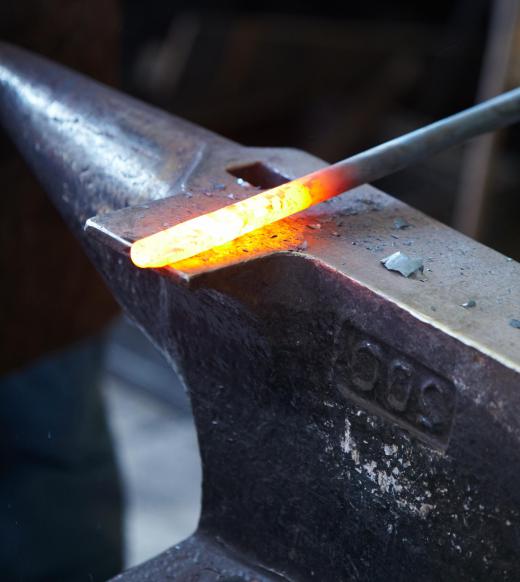An anvil is a solid block of steel, wrought iron, or another similar strong metal. The anvil has been in use by humans for centuries, with basic anvils being used to work metals at the beginning of the Bronze Age. The anvil is used in a variety of metal working situations, from jewelsmithing to shoeing horses, and most metal workers have at least one anvil in their tool collection. The anvil is a cornerstone of metalworking, allowing metal to be quickly worked when hot or cool against a strong and resilient surface.
Usually an anvil has a long protruding horn and one flat side called a heel, although some anvils have a horn and an irregularly shaped heel. The horn is used in some detail work and to mold metal into curved shapes. Some anvils also have holes in which various tools can be inserted, as well as a pad to brace metal on while it is being chiseled. The top of the anvil is usually flat, although some curved anvils are used for specialized applications.

The basic shape of the anvil has not changed in thousands of years, because it is a highly functional, strong, and flexible shape. Metal can be easily formed on an anvil, and it is a relatively portable work surface, depending upon the size of the anvil. Anvils can range in size from very small, delicate models for jewelsmithing to large anvils which may weigh hundreds of pounds, used in large scale ironworking projects.
Farriers, who shoe horses, usually have a small portable anvil and forge to do their work with, allowing them to mold shoes to the specific shape of the horse's foot. Jewelsmiths often have an assortment of anvils in a variety of finishes so that they can use the right tool for the right job. This was especially for soft metals like gold which could be damaged during the metalworking process. Iron workers work with much larger and robust anvils which are able to take heavy hammer blows.
When working with cold metal, the anvil is used to brace the metal, which may also be clamped. The metal can be hammered for effect or shaped as needed, depending on the thickness. In other cases, the metal will need to be heated in order to be worked, and is handled with tongs and gloves to avoid severe burns. Once the metal has reached a workable temperature, it is transferred to the anvil for shaping.
Ever since she began contributing to the site several years ago, Mary has embraced the exciting challenge of being a About Mechanics researcher and writer. Mary has a liberal arts degree from Goddard College and spends her free time reading, cooking, and exploring the great outdoors.

